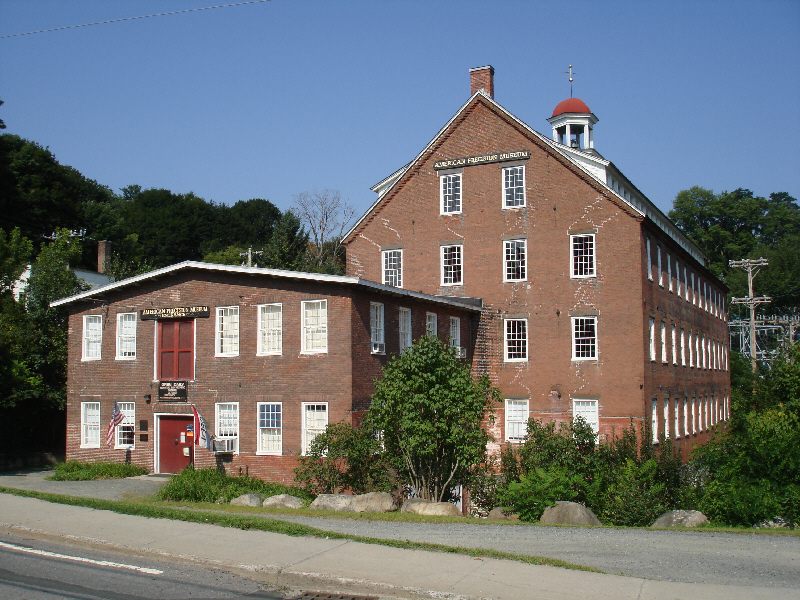Precision manufacturing plays a significant role in American history. But how many are truly aware of that history? The American Precision Museum (APM) in Windsor, Vermont offers unique opportunities to immerse yourself in stories of innovation that shape American manufacturing, participate in educational programs and open your mind to the possibilities of future innovation.
A piece of manufacturing history
The museum not only tells the story of precision manufacturing through the years: it represents a piece of history itself. Housed in the former Robbins & Lawrence Armory, APM is a designated National Historic Landmark that is home to the largest collection of historically significant machine tools in the US.
Built in 1846, the four-story factory was where Samuel Robbins, Nicanor Kendall, and Richard Lawrence led the production of new machinery, adapting the technology for gun production to be used for other parts and consumer goods. It was also here that they developed methods of producing interchangeable parts — for example, the corresponding component parts of pistols — that led to the establishment of the “American System.”
Museum exhibits
The APM’s many exhibits provide immersive education on machines, as well as individuals who have played significant roles in American manufacturing and innovation throughout the years.
Pop-up exhibits
The APM runs rotating “pop-up” exhibits that change every 6-8 weeks, which can be found in the museum lobby.
Digital exhibit: Visitor Orientation Film
Igniting Innovation: The Manufacturing Revolution in Precision Valley, an 11-minute film about the history of Precision Valley along the Connecticut River — from Springfield, MA to Hartford, CT — provides a captivating introduction for visitors upon entering the museum.
The Science and Technology of Measurement
A new exhibit that showcases historic precision measurement tools, including Edison’s gauge blocks and a ballistic chronograph.
Shaping America
Beginning in the 1840s, the museum’s signature exhibit guides visitors through the history of Precision Valley, its toolmakers and machinists, and their influence on American industrialization, culture and the course of history.
Educational programs
Education is an important part of the museum’s mission, focusing on the past, present and future of American precision manufacturing. Programs are open to all ages (not just students) starting with kindergarten. The following are some examples of the programming at APM.
STEM program: a grant-funded program, through which the museum provides free STEM kits and curriculum to local 4th-6th grade classrooms, covering topics pertaining to the APM
Learning Lab: a space for hands-on activities that challenge participants to collaborate to solve problems. The Learning Lab offers access to technology like cobots and 3-D printers.
Innovation Station: visitors can watch demonstrations of both historic and modern machines. Museum interns use the machines to create various items, which are available for purchase in the gift shop. Machines in the Innovation Station include:
- Haas DT-1 CNC Machining Center/Midaco Pallet Changer
- Fanuc LR Mate 200 iD Articulated Arm Robot
- Bridgeport Milling Machine with HEIDENHAIN Conversational CNC Controller
- Caron Engineering D-Tect It Machine Condition Monitoring System
- Ultimaker 3D-printer
FREQUENTLY ASKED QUESTIONS
- What is the American Precision Museum (APM)’s mission?
The APM’s mission is “to capture the imaginations of young and old with the spirit of innovation, problem solving and design demonstrated through the dynamic story of the machines and people that form the foundation and future of the manufacturing industry in America.” The museum aims to preserve its historic landmark property and collections, inspire future innovators and build communities that support manufacturing in years to come.
- What is the history of the building?
The building where APM is housed was the original Robbins & Lawrence Armory, constructed in 1846 for Samuel Robbins, Nicanor Kendall, and Richard Lawrence. It is considered a National Historic Landmark and played a significant role in manufacturing history and innovation in the US.
- Why should I visit the APM?
Whether you’re an engineer, machinist, history buff, or simply curious about how things work, this museum provides a fascinating look at precision manufacturing through the years — and how the innovators of our past have influenced modern American culture. It also exposes visitors to modern machine tools they would not normally see up close.
GLOSSARY TERMS
- American System
The “American System” refers to the American System of Manufacturing, which consists of several elements:
- The division of labor: using machine tools run by workers to produce identical parts, instead of having one individual hand-craft each part
- Interchangeable parts: through measurement and quality assurance, developing component parts that correspond to different models (for example, that of pistols)
- Mechanization: utilizing machine tools for different operations
- Machines as a resource: using machines instead of manual labor whenever possible, not only to save money, but to increase resources and improve working conditions.
- Precision Valley
An area that follows the Connecticut River from Springfield, MA to Hartford, CT, where waterpower from the river was utilized to run precision machines in the mid-1800s. As a result, manufacturing and machine tools played an important role in the area’s economic growth.
- Cobots
- Cobots are collaborative robots that complete automated measurement procedures alongside human operators. A cobot is made up of a lightweight robot arm that is capable of assisting with manufacturing, assembling, and packing tasks in addition to taking part in the actual process of industrial measurement. Cobots are the metrology of the future in action today. These machines streamline the measurement process and can help to transform the work being done at the scientific and industrial levels.

